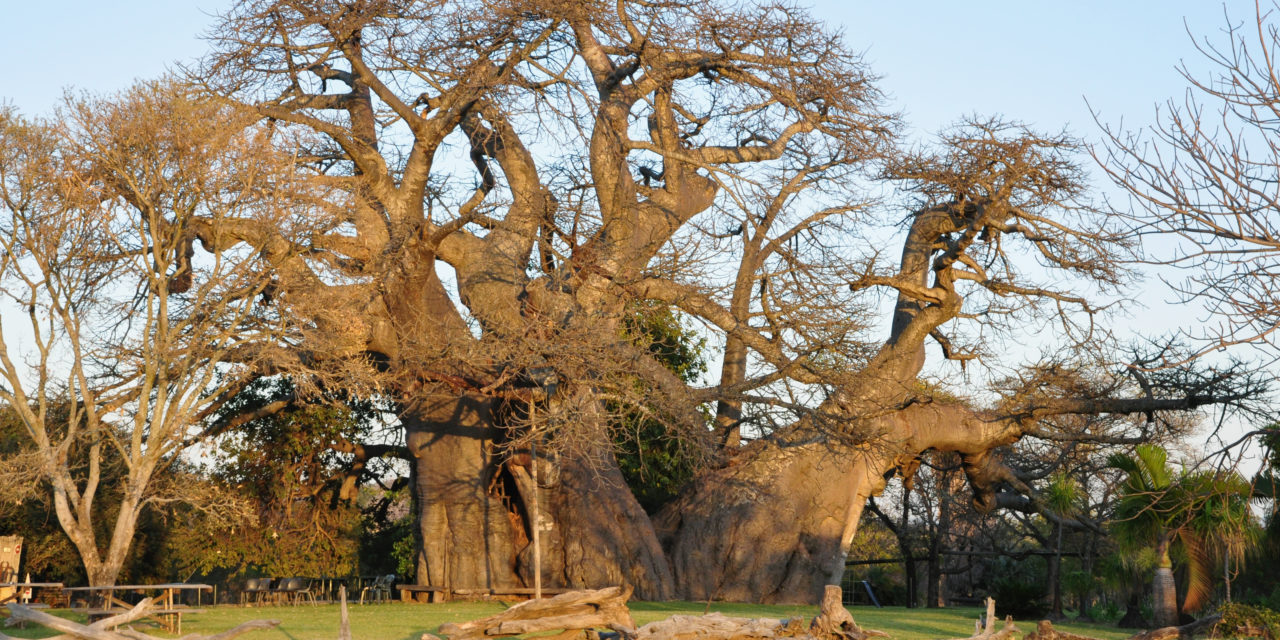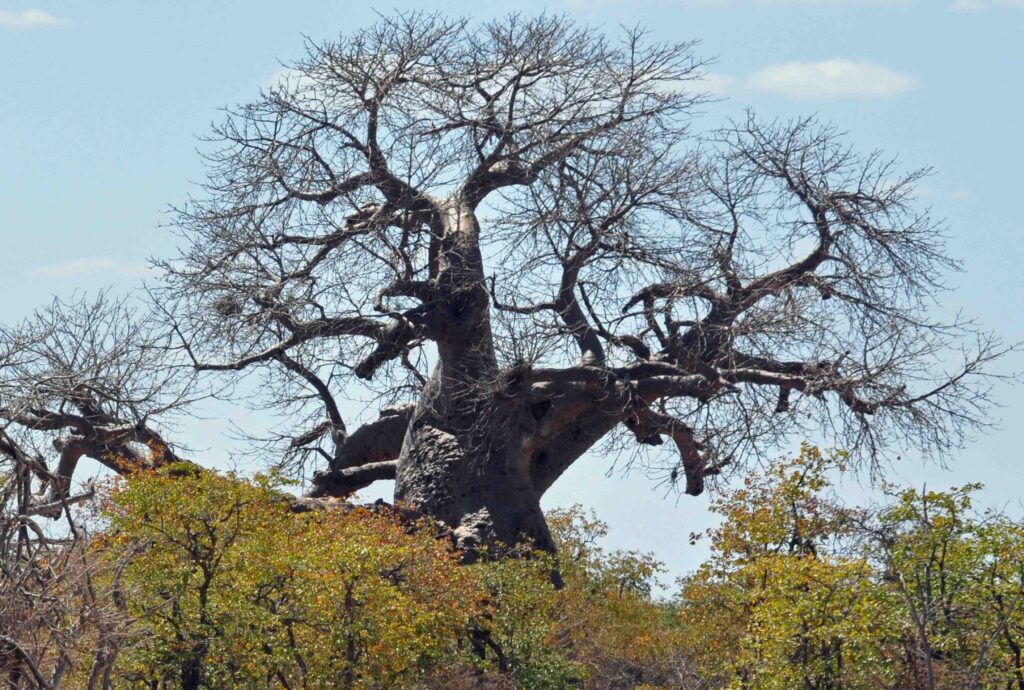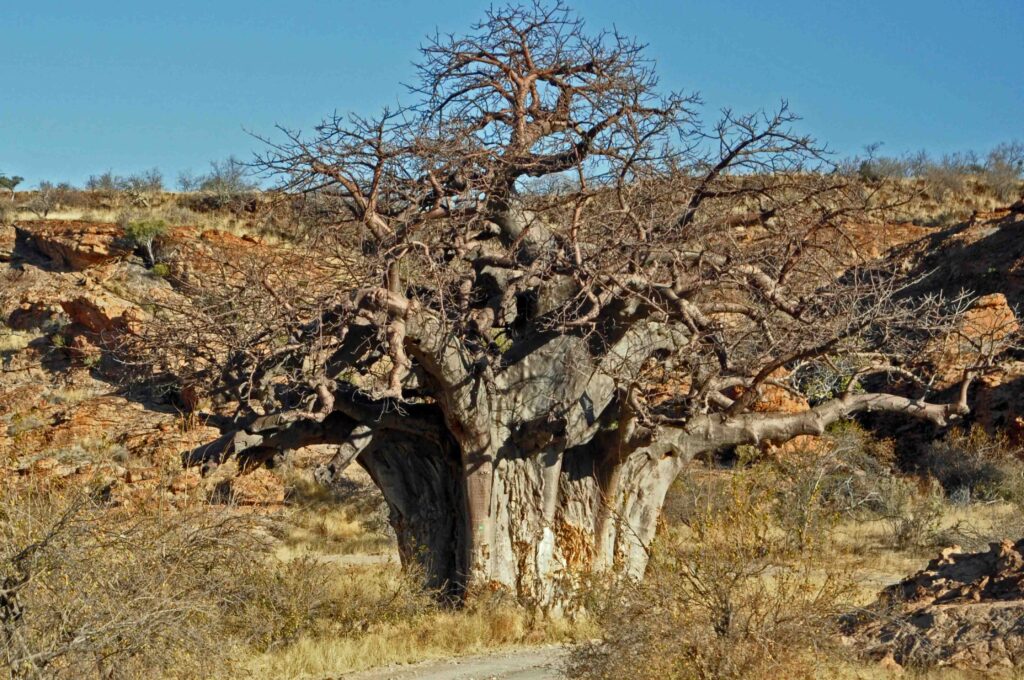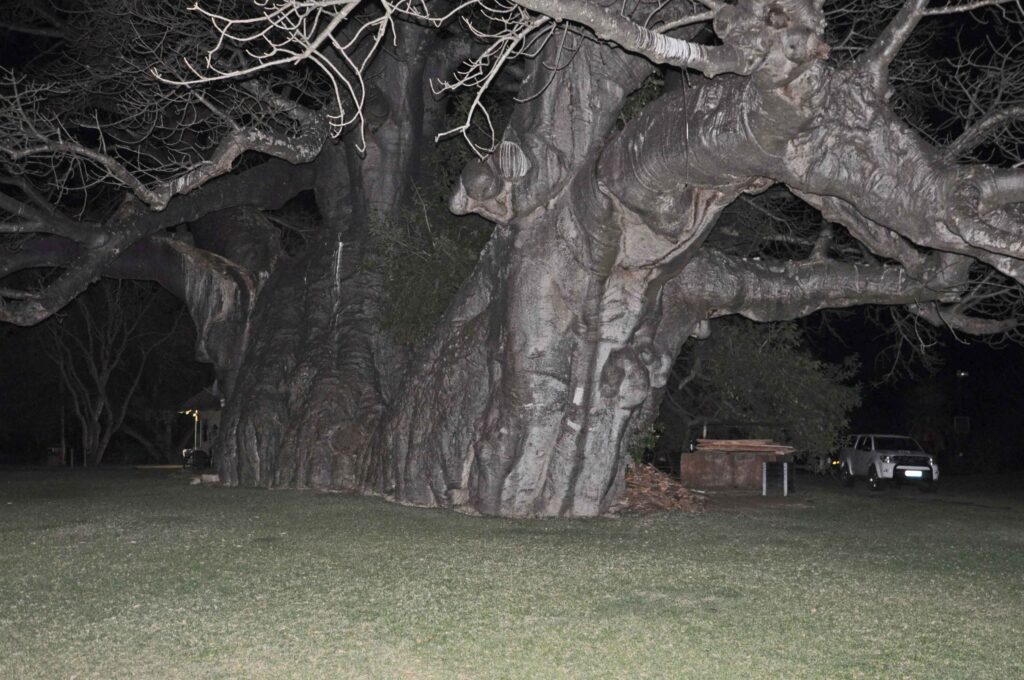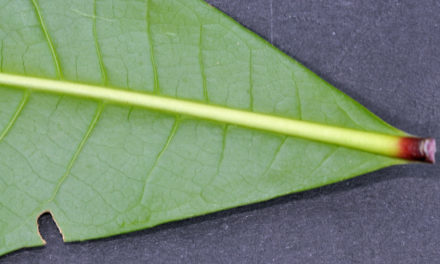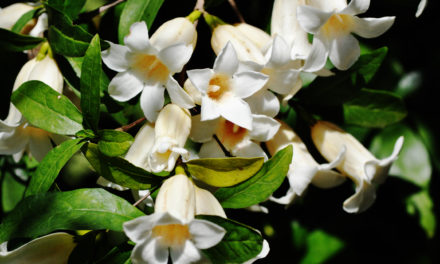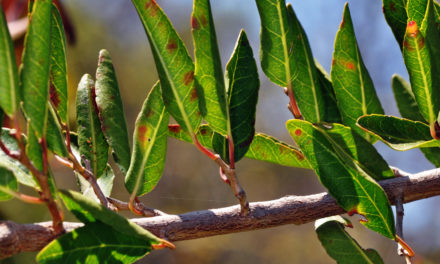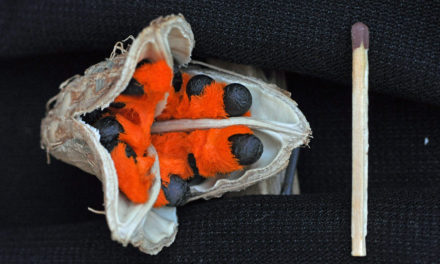Adansonia digitata
General Info – summary
This pachycaul & spineless Tree has smooth bark may reach 15+m high & 12+m wide. This deciduous tree has simple Leaves that become digitate. Large, short lasting, night opening, white, waxy, bisexual & actinomorphic Flowers have protruding stamens surrounding the superior ovary with its simple style. Fruit is a woody indehiscent capsule with many kidney-shaped black seeds imbedded in a white pulp.
Description
Previous Name: Adansonia kilima, Adansonia situla.
SA Tree No. 467.
Common names: (Afr) Kremetart boom, Kremetartboom, Kremetatboom, Krimetatboom, Baobab. (Eng) Monkey-bread Tree, Cream of Tartar tree, Cream-of-tartar-tree, Lemonade Tree, Tartaric Acid Tree, Upside down tree. (IsiNdebele) Umkhomo. (isiZulu) Isimuhu, Isimuku, Umshimulu. (Setswana), Mowana, Ximuvu, Ximuwu. (Tshivenda) Muvhuyu.
Family: Malvaceae. (Wild Pear, Gossypium – cotton, baobab and Hibiscus family). This family has 240+ genera and 4 200+ species. Most species are herbaceous, but a few are trees. Indigenous genera that have trees on this website includes Adansonia (baobab), Cola, Dombeya, Grewia, Hibiscus, Sparrmannia and Sterculia. Stems contain mucous canals. The usually alternate, often compound or palmately veined Leaves of all possess stipules and apart from Adansonia, remain simple. Flowers are regular, bisexual or unisexual and have 5 petals (Sparrmannia africana has 4) with regularly arranged overlapping edges. Petals are absent in Cola and Sterculia. There are 5 to many stamens with filaments often united into a staminal tube. This surrounds the superior Ovary with axile placentation and its simple Style and capitate or lobed Stigma. Fruits are usually nuts, schizocarps or loculicidal capsules.
Name derivation: Adansonia – Named by Carl Linnaeus after the man who first collected it: Michel Adanson (1727-1806). He was a French surgeon and botanist who reported seeing the tree while travelling in Senegal between 1749 and 1753. digitata refers to the digitate mature leaves – shaped like the fingers of a hand. The genus Adansonia is widely distributed in the hot dry parts of Africa, Madagascar (4 species), Northern Namibia, and northern Australia. Adansonia digitate is only species of this genus in South Africa.
Conservation: National Status: L C. (Least Concern). Assessment: 2005 (W. Foden and L. Potter).
Tree
This massive Tree completely dominates the landscape wherever it grows (photo 258 & 214). The relatively short (usually 10-15m high), spineless tree with its enormous tapering branches may reach 11m in diameter. The circumference of the Bowl (the stem or trunk of a tree) can reach 28m or more and the squat tree is said to be pachycaul (has a trunk with a massive girth compared to its height – photo 345). The young tree has a smooth Bark and is round with a long neck – like a wine bottle with a branching twig in its cork. The glossy smooth bark (photo 214) is up to 10cm thick, pinkish grey, to reddish brown or coppery. As it ages, the bark remains soft, fibrous and may be deeply folded and seamed. The bark on some trees in Mapungubwe has a purple sheen (photo 258). In this photo, Mopani bushes (Colophospermum mopane) surround the baobab tree. Trees develop Side roots that are up to 15m long. The broad base of a mature tree suddenly changes into comparatively small thin, spreading, tapering Branches (photo 258) which “resemble” roots – hence the notion that “god planted the tree upside down”. This feature is especially visible in winter when there are no leaves (photo 345 & 258). The heartwood of old trees often dies, and new bark grows on the inside forming an accommodation area or holding large volumes of water. In dry times, many animals make use of this water. The Sunland baobab tree with a pub built inside (photo 214) could hold 15 people and the wine cellar kept a constant temperature of 22 degrees C.). Unfortunately, the tree fell in 2017. At that time, the Sunland Baobab was the biggest baobab in the world (22m high with a circumference of 47m). Adrian Patrut, a professor of Inorganic and Radiochemistry from Romania worked out that this tree was made up of 5 stems and was about 1 4oo year’s old.
- 258. 2014/09/01. Mapungubwe NP. Photo: David Becking
- 345. 2014/09/01 Mapungubwe NP. Photo: David Becking.
- 214 2014/09/06. Modjadjiskloof (Duiwelskloof). Photo: David Becking.
Leaves
This distinctly deciduous tree loses the alternately or spirally arranged Leaves at branch ends for up to 9 months. In their natural habitat, they are usually the first tree in the area to lose leaves and the last to generate new ones. The new leaves that form in spring or early summer, are initially simple and mature leaves become digitate (hand-like: compound leaves with leaflets arising from a single point). These different stages of development make the young plants difficult to identify. The 3 to 9 Leaflets are oblong, oval or widely lanceolate (lance shaped). They are glossy dark green to bright green and gathered at the ends of branches. Occasionally they may occur on short spurs. The terminal leaflets are the largest. Each leaflet is up to 15 x 7cm and has short soft hairs, particularly when young. The Apex and Base both taper. The leaflet Margin is entire (with a continuous margin, not in any way indented). The Petiole (stalk of a leaf) is up to 15cm long. The Petiolules (stalks of leaflets) are short to absent. Leaves have short-lived free Stipules (basal appendages of the petioles). Crushed leaves are pungent.
Flowers
The solitary big flower Buds occur in leaf axils. They open shortly after sunset into large, white, waxy and drooping Flowers. These solitary flowers are bisexual and actinomorphic (Regular, symmetrical. Flowers are vertically divisible into similar halves by more than 1 plane passing through the axis). They are usually about 15cm in diameter and are 5-merous (floral parts in 5’s). The Calyx is deeply lobed and valvate (meeting by the edge without overlapping). Shortly after sunset, these Sepals curl back to reveal the Corolla with its white, wrinkled Petals. These petals become brown and curl backwards exposing a large group of many short living Stamens with Filaments that are fused at the base. These filaments form a long distinct tube that surrounds the white Style and are shed with the petals. The remainder of the filaments protrude, noticeably ending with brown to orange Anthers. This is a special sight. Each anther has 1 pollen sac which releases its pollen through a longitudinal slit. Picked flowers rapidly turn brown. After pollination at night by fruit bats, e.g. the large straw-coloured fruit bat Eidolon helvum, which may travel in massive colonies. These bats are now considered as near threatened. Fortunately, nocturnal and tree-dwelling Bush Babies, with their saucer-shaped eyes, as well as insects are also involved in pollination. During the second day, the Petals and Stamens fall away revealing the superior Ovary, which has 5-10 locules (chambers / compartments). Extending from this is the single, long, simple Style, which bends with about half its length, protruding horizontally. It ends in a small saucer-like Stigma with 5-10 lobes. The fallen parts are unpleasantly scented (for us). (Oct-Dec).
Fruit
The somewhat ovoid (egg-shaped) and large (up to 24 x 16cm) Fruit is a Capsule (a dry fruit resulting from the maturing of a compound ovary which usually opens at maturity by one or more lines of dehiscence). It is borne singly in leaf axils (axil – the upper angle between a lateral organ, such as a leaf, and the stem that bears it. Grey to golden hairs cover the hard, woody indehiscent capsule that changes from green to greyish brown as it matures. The Calyx does not continue growing with the fruit that hangs down from the branches. Many kidney-shaped, black Seeds are imbedded in a whitish pulp containing appreciable quantities of tartaric acid (white organic acid occurring in many plants – including grapes and baobab fruit). Tartaric acid develops naturally in the fermentation process and acts as a natural exfoliator and refiner because it encourages the shedding of the outer layer of skin cells. (Jan-May).
Distribution & Ecology
Most of the South African baobab Trees are found to the North West of the Soutpansberg in “Mopaniland” (where mopane trees – Colophospermum mopane, are present). This includes Limpopo province and the Oliphants River in the East. Adansonia digitata also grows in Northern Province, North West and Mpumalanga – in dry hot and sandy places. They often grow on alluvial soils. Beyond our borders, they grow in Kenya, Tanzania, Burkina Faso Sudan, Zimbabwe, Botswana, Northern Namibia (Caprivi Strip) into tropical Africa and Madagascar. In Mozambique the tree is wide spread. Mozambique is also the home to a second species: Adansonia kilima. All trees normally develop at low altitudes of up to 1 700m – usually less, and with a rainfall of between 300-500mm per year. They grow best in deep well-drained soil. Trees occur in flood plains and along rivers. The tree centre often dies and may fill with water. Many animals consume this water – especially in dry times. It may become a breeding place for mosquitoes. Young baobab trees can develop a swollen underground organ for water storage. Animals eat the Leaves. The Flowers attract small birds, bats, insects and reptiles. Physically damaged or burned Bark usually recovers well. Baboons and monkeys seek out the Fruit. Elephants, antelope and cattle eat the spongy, soft Wood – especially when water is in short supply. Some trees have part of the trunk stripped by elephant, but the tree has the ability to replace damaged bark. When a tree eventually dies, it disintegrates rapidly and becomes a huge fibrous mass. This has occurred in plant in the intro photo. Seed dispersal includes seeds transported by animals in their digestive system.
Ethnobotany
The soft, light yellow, spongy Wood contains a lot of water and is of no use for building. Chewed wood may relieve thirst. A tree may live for in excess of 2 000 years. Boiled Leaves are edible as a vegetable and have a taste similar to that of spinach. Caterpillars that feed on the leaves are an important food source for some people. Pollen is used to make glue. White pulp, from inside the Fruit has a pleasant tart flavour and a high concentration of vitamin C, calcium, and thiamine. When dry the powdery pulp can be mixed with water to make a refreshing drink – hence the name “Cream of tartar tree”. The Bark contains an excellent fibre from which rope, floor mats, fishing nets and woven material are made. The Sap from crushed twigs releases an aromatic perfume, which is worth trying. The Seeds remain viable for a number of years. They are edible and nourishing – containing a high level of vitamin C. Seeds germinate well and should produce flowers after 16 years or so and, by this time, trees have a diameter of more than 30cm. Seeds germinate better after passing through the gut of animals. Plants are sensitive to waterlogging and severe frost. After roasting, seeds are used to make a nutritious coffee. Regrettably, picked flowers do not last long. Cattle consume fallen Flowers. Hollowed out Trunks are used as places of safety and for food storage. Local medicine makes use of the bark and other parts. In 1941 the baobab was declared a Protected tree.
References
Burrows, J.E., Burrows, S.M., Lotter, M.C. & Schmidt, E. 2018. Trees and Shrubs Mozambique. Publishing Print Matters (Pty) Ltd. Noordhoek, Cape Town.
Coates Palgrave, M. 2002. Keith Coates Palgrave Trees of Southern Africa, edn 3. Struik, Cape Town.
Lawrence, G. H. M, 1951. Taxonomy of Vascular Plants. The Macmillan Company, New York. Tenth Printing 1965.
Mhlongo, N.N. 2023. Adansonia digitata L. National Assessment: Red List of South African Plants version . Accessed on 2025/03/16.
Palmer, E. & Pitman, N. 1972. Trees of southern Africa. Balkema, Amsterdam, Cape Town.
Schmidt, S. Lotter, M. & McCleland, W. 2002. Trees and Shrubs of Mpumalanga and the Kruger National Park. Jacana, Johannesburg.
van Wyk, B. & van Wyk, P. 1997 Field guide to Trees of Southern Africa. Struik, Cape Town.
https://en.wikipedia.org/wiki/Straw-coloured_fruit_bat#/media/File:Eidolon_helvum_fg01.JPG
https://en.wikipedia.org/wiki/Adansonia_digitata
http://plantzafrica.com/plantab/adansondigit.htm
http://www.krugerpark.co.za/africa_baobab.html
http://posa.sanbi.org/flora/browse.php?src=SP
https://www.researchgate.net/profile/Adrian-Patrut
African Baobabs with False Inner Cavities: The Radiocarbon Investigation of the Lebombo Eco Trail Baobab
Adrian Patrut, 1 ,* Stephan Woodborne, 2 Karl F. von Reden, 3 Grant Hall, 4 Michele Hofmeyr, 5 Daniel A. Lowy, 6 and Roxana T. Patrut. PLos One. 2015.

